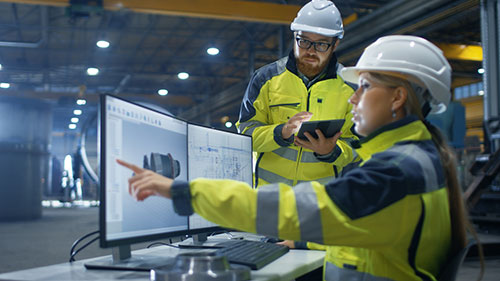How will construction technology advance in 2018 and beyond? From drones and augmented reality (AR) to exoskeletons and the Internet of Things, here are five tech trends that will impact the industry.
Exoskeletons: It may sound like science fiction, but exoskeletons are already making an impact in the construction industry, where construction workers are 16-percent more likely to have a work-related musculoskeletal disorder, according to the Centers for Disease Control and Prevention (CDC). Those injuries could become a thing of the past, as more and more construction firms begin employing exoskeleton technology, which improves posture, takes strain off the body and helps workers lift heavy objects, while working longer without fatigue.
Augmented Reality: While virtual reality replaces the actual world with simulated versions; augmented reality adds virtual elements to real-world settings. Builders are starting to leverage this technology to overlay 3D models of their projects onto real-world views of construction sites. This allows clients to visualize finishes and design elements before a build even starts. Although it’s not quite mainstream, AR is expected to become very big in the near future.
IoT: An acronym for Internet of Things, IoT essentially refers to devices that share information via a network without human assistance. Modern examples include everything from vehicles with built-in sensors to farm animals with biochip transponders. In regard to the construction industry, IoT offers a number of benefits, including:
- Remote operation of construction machinery
- Tracking of equipment and tools
- Automated just-in-time provisioning
- Automated energy-efficiencies
- Automated logging of work hours
- Augmented Reality (AR)
- Building Information Modeling (BIM)
Drones: Unmanned aerial vehicles (UAVs) are already being used by a number of construction companies, and the trend is expected to grow quickly. Right now, UAVs are typically used for progress reporting, health and safety inspections and site surveying. While the media fixates on how drones might be used in package delivery, it’s the construction industry that’s predicted to be the largest user of commercial drones in the coming years. Much of this has to do with how well they can capture accurate data on large areas of land, along with their ability to enter potentially hazardous zones that are too dangerous for human surveyors.
Mobile Field Software: Modern mobile applications are helping workers communicate and access data in real-time right on the jobsite. Instead of having to shuffle through stacks of paperwork, organizations enjoy seamless integration for things like management, supply chain, accounting and payroll.
3D Printing: Over the past year, more and more construction companies have begun using 3D printing technology to produce physical objects at all levels of scale. Highly accurate digital design information allows the technology to be used for modeling, component manufacturing and rapid prototyping. 3D printing technology has even been used to create full scale houses and bridge components. While 3D printing for construction is still in its infancy, it offers endless potential to cut costs related to deliveries and skilled labor.
As a builder you can protect your business with 2-10 Structural Warranties; learn more today!








